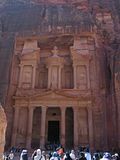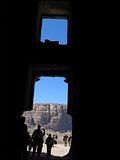9am
Undoubtedly the most famous attraction in Jordan is the Nabatean city of Petra, nestled away in the mountains south of the Dead Sea. Petra, which means "stone" in Greek, is perhaps the most spectacular ancient city remaining in the modern world.
Despite Mr Hassan's suggestion that we visited the tombs of several famous muslim clerics and the 'Ashaab-e-Kahf' cave the story of seven sleepers, we decided to stick to Petra although it would be three hour drive away from Amman.
Mr Hassan sent his colleague Mr Mohammed to accompany us to Petra. Unlike the chatty Mr Hassan, Mr Mohammed is a quite person. I asked Jules to sit in front as I don't have any topic to talk with Mr Mohammed.
Earlier, we received sms from Has asking where we are, but since there is no more credit, we could not reply her sms. Seconds later she called. Told her that we saw the news and we are no longer in Madrid but now are in Amman.
Petra is located just outside the town of Wadi Mousa in southern Jordan. It is 260 kilometers from Amman via the Desert Highway and 280 kilometers via the King’s Highway. All along the journey, we were very sleepy as for the past few kilometres outside Amman, it's all arid landscape with badouin camps scattered in the dessert.
Halfway we stopped at a roadside tourist craft plaza where Mr Mohammed had his douse of a cup of coffee while we browse the souvenirs. This was much better than the one Mr Hassan brought us yesterday.
On the way, Jules phone rang. It was for me. It was Along asking anxiously where I was. Told her that we were already in Jordan and will be flying back tonight.
"Mak risau. Abah sampai call Wisma Putra tanya kalau ada orang Malaysia kat sana," she told me.
No no.. tell mom and dad, we were already in Jordan. She said okay.
Petra

The city was the capital of the Nabateans Arabs who dominated the lands of Jordan during pre Roman times and they carved this wonderland of temples, tombs and elaborate buildings out of solid rock. The Victorian traveller and poet Dean Burgon gave Petra a description which holds to this day "Match me such a marvel save in Eastern clime, a rose-red city half as old as time."
Yet words can hardly do justice to the magnificence that is Petra. In order to best savor the atmosphere of this ancient wonder, visit in the quiet of the early morning or late afternoon when the sandstone rock glows red with quiet grandeur.
For seven centuries, Petra fell into the mists of legend, its existence a guarded secret known only to the local Bedouins and Arab tradesmen until in 1812, a young Swiss explorer and convert to Islam named Johann Ludwig Burckhardt heard locals speaking of a "lost city" hidden in the mountains of Wadi Mousa.
Burckhardt disguised himself as a pilgrim seeking to make a sacrifice at the tomb of Aaron, a mission which would provide him a glimpse of the legendary city. He managed to bluff his way through successfully, and the secret of Petra was revealed to the modern Western world.
We were given a guide who will give a tour on Petra. Also included in our tour was horse ride. Unfortunately instead of telling us this the guide gave impression that we can take a horse ride with extra charge.
Archaeologists believe that Petra has been inhabited from prehistoric times. Sometime during the sixth century BCE, a nomadic tribe known as the Nabateans migrated from western Arabia and settled in the area. They grew rich by levying taxes on travellers to ensure safe passage through their lands. The easily defensible valley city of Petra allowed the Nabateans to grow strong.
From its origins as a fortress city, Petra became a wealthy commercial crossroads between the Arabian, Assyrian, Egyptian, Greek and Roman cultures. Control of this crucial trade route between the upland areas of Jordan, the Red Sea, Damascus and southern Arabia was the lifeblood of the Nabatean Empire and brought Petra its fortune.

Much of what is known about Nabatean culture comes from the writings of the Roman scholar Strabo. He recorded that their community was governed by a royal family, although a spirit of democracy prevailed. Strabo also notes the materialism of the Nabateans.
With its incorporation into the Roman Empire, Petra began to thrive once again. The city may have housed 20,000-30,000 people during its heyday.
The fortunes of Petra began to decline with the shift in trade routes to Palmyra in Syria and the expansion of seaborne trade around Arabia. In 363 CE, when the free-standing structures of Petra were thrown to the ground in a violent earthquake. Fortunately, Petra’s greatest constructions were preserved, carved as they are into the rock faces.
It is not known whether the inhabitants of Petra left the city before or after the fourth century earthquake. The fact that very few silver coins or valuable possessions have been unearthed at Petra indicates, however, that the withdrawal was an unhurried and organized process. One theory holds that the city of Petra was primarily a religious and administrative center, used occasionally as a fortress during times of war.
It seems clear that by the time of the Muslim conquest in the seventh century CE, Petra had slipped into obscurity. The city was damaged again by the earthquake of 747 CE, and housed a small Crusader community during the 12th or 13th century. It then passed into obscurity and was forgotten until Burckhardt rediscovered it for the outside world in 1812.
It was so dramatic walking along 2km Siq path, a narrow winding valley flanked between these tall pink stones. The path narrows to about five meters and the walls tower over 200 meters overhead, casting enormous shadows on the niches that once held icons of the gods Dushara and al-Uzza meant to protect the entrance and hex unwelcome visitors.
The entrance to the Siq was once topped by a ceremonial arch built by the Nabateans that had survived and remains can still be seen today. It heightened the excitement that at the end of this tunnel, we will found a huge breathtaking view of what the local called "Rose Treasure".
Tourists had started pouring in during this month of the year. According to Mr Hassan, March and April are the best time to visit Amman where the weather is very pleasant during the spring time. Besides the normal mat sallehs, Chinese tourists in buses came to visit Petra. The sound of tourists entertwined with the sound of pounded hooves of horses or horse carts ferrying tourists who were too tired to make a journey back to the entrance.
We met a few Malaysian students there but we just pretend to jual mahal to them. Anyway, there were just boys.
After the winding pathway, the Siq suddenly opens upon the most impressive of all Petra’s monuments al-Khazneh (Arabic for "The Treasury"). One of the most elegant remains of antiquity.
It is carved out of solid rock from the side of a mountain, and stands over 40 meters high. Although it served as a royal tomb, the Treasury gets its name from the legend that pirates hid their treasure there, in a giant stone urn which stands in the center of the second level. Believing the urn to be filled with ancient pharoanic treasures, the Bedouins periodically fired guns at it: proof of this can be seen in the bullet holes which are clearly visible on the urn.
The majestic Rose Treasure drew oooh and aahhh from the tourists including us. It was really like the "Indiana Jones - The Last Crusade".
We entered the Treasure with hope of finding more "treasure" feast for the eyes but it was not so. It was an empty hall carved from the beautiful red stones. Excavations are still being carried out as archeologists found more historical sites around the Treasure.
The guide left us here as he claimed that he wanted to perform the Jumaat prayer. We follow the tourists flow that leads down the ancient city. The number of niches and tombs increases, becoming a virtual graveyard in rock arching around behind the 8000-seat Amphitheater.
Instead of turning to the amphitheater, we headed to rock of Jabal Khubtha where the Royal Tombs are located. The first is the Urn Tomb, with its open terrace built over a double layer of vaults. The room inside measures 20 by 18 meters, and the patterns in the rock are striking. The Urn Tomb commands an impressive view and was once used as a church in Byzantine times.
Next along is the Corinthian Tomb, allegedly a replica of Nero’s Golden Palace in Rome. Finally, the Palace Tomb is a three-story imitation of a Roman palace and one of the largest monuments in Petra.Around the corner to the right is the Mausoleum of Sextus Florentinius, a Roman administrator under Emperor Hadrian.
From there we went down back to the Amphitheatre which was originally thought to have been built by the Romans after their defeat of the Nabateans in 106 CE.
It is now believed that the Nabateans cut the Amphitheater out of the rock around the time of Christ, slicing through many caves and tombs in the process.
Along the colonnaded street you will see the ruins of the public fountain, or Nymphaeum. At the northwestern end of the colonnaded street is the triple-arched Temenos Gateway, which was originally fitted with wooden doors and marked the entrance into the courtyard, or "temenos", of the Qasr al-Bint. To the right of the Temenos Gateway, or Triumphal Arch, is the Temple of the Winged Lions. This was named after the carved lions that adorn the capitals of the columns. The temple was dedicated to the fertility goddess Atargatis, who was the partner to the main male god, Dushara.
We have agreed to meet Mr Mohammed outside after 2pm, so after spending time inside the Siq sitting on the bench and people watching and admiring the valley, we walked out to meet him for our late lunch at one of the hotel. I noticed there was a iron tower of look like communication tower on top of a house next to the hotel. A smaller version of Eiffel Tower.
We left Petra and again we stopped at another stop-over for Mr Mohammed's dose of coffee. Jules went to the toilet. She said it was an expensive one. Either (I think) .75 dinnar or US$1. She paid the US$1.
The temperature dropped a bit when we left the stop-over and on the way back to the souvenir shop. Mr Hassan has gave instruction to Mr Mohammed to bring us there and Jules brought her plastic bag of the souvenirs with her.
It was already evening rush hour time when we reached the souvenir shop. Jules brought her stack and showed the owner that she was overcharged. The owner was obliging and refund the money to her.

0 Comments:
Post a Comment
<< Home